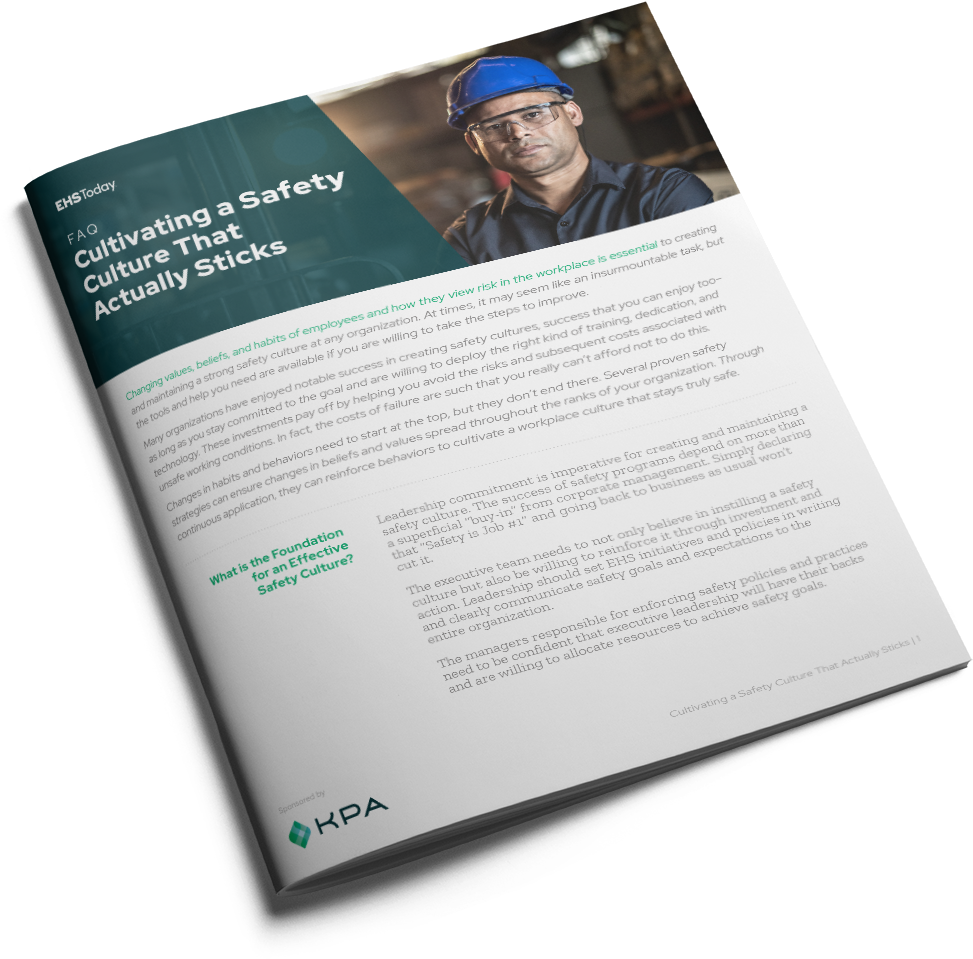Get ready to step into the Safety Meetings Safety Lab, where we break down the latest research and studies in workforce safety. Join us as we dive deep into the data and uncover fresh insights to make your workplace safer, smarter, and more informed.
We dive into a new study, published in the Journal of Safety Science that looked at over 12,000 injury cases to understand how a company’s Psychological Safety Culture affected how long employees were off work and the costs involved.
And today, well, we’ve got a fascinating one for you. It’s all about what happens after an injury and how this concept called psychosocial safety climate or PSC for short plays a larger role than you might think.
[00:00:30]
Yeah. You know, we often just focus on the incident itself.
[00:00:34]
Exactly. But this new study we’re diving into today, published in safety science really caught our eye. They looked at a massive amount of data, over 12,000 injury cases, in fact, to see if a company’s PSC affected how long employees were off work and the costs involved.
[00:00:49]
And this is data from 100 different Australian companies, so it’s a broad scope, right?
[00:00:55]
Absolutely. So before we get into the findings, can you give us a quick rundown on what PSC actually means in a workplace setting?

Cultivating a Safety Culture That Sticks
Download the frequently asked questions safety culture for KPA and EHS Today to learn how to cultivate a safety culture that sticks. Which investments pay off by helping you avoid the risks and costs associated with unsafe working conditions.
[00:01:03]
Sure. Imagine a workplace where your mental well-being is truly prioritized, not just talked about, but genuinely valued. That’s psychosocial safety climate in a nutshell.
[00:01:15]
That sounds nice in theory, but what does that look like in practice? How does a company actually create that kind of environment?
[00:01:22]
It’s multifaceted, but one of the biggest things the study emphasizes is leadership. You know, companies where managers don’t just talk the talk, but actually walk the walk when it comes to prioritizing mental health. Those are the orgs that see a real difference.
[00:01:39]
So it’s one thing to have a mental health policy, but it’s another thing entirely to actually live it out day-to-day.
[00:01:45]
Absolutely, it’s the classic actions speaking louder than words. prioritizing psychological well-being, like adjusting a deadline or a shifting some workload: that speaks volumes to employees. And open communication is another huge piece of the puzzle.
[00:02:01]
So making it OK to talk about mental health without fear of judgement.
[00:02:05]
Exactly. Creating a workplace where those conversations are welcomed, not shunned. That’s crucial for a high PSC. But it’s not just on management entirely.
[00:02:18]
Right, it can’t be just one department telling everyone else what to do.
[00:02:23]
For PSC to really thrive, everyone needs to buy in: senior management, frontline staff, everyone needs to be part of creating that culture of support.
[00:02:32]
It’s got to be ingrained in the company’s DNA, not just a line item on a checklist.
[00:02:37]
Exactly. So, let’s get into some of the study’s findings, because it turns out that the impact of a strong PSC on those things we talked about: time out after an incident, costs; Its pretty remarkable.
[00:02:49]
Alright, I’m hooked. Give us the good stuff – How much of a difference are we talking about here?
[00:02:53]
Well, when they looked at the data, companies with a high PSC had significantly fewer days lost after an injury. We’re talking an average of 68 days.
[00:03:03]
68 days. OK, that’s a lot
[00:03:06]
Compared to a whopping 177 days for companies with low PSC.
[00:03:11]
Whoa, hold on. That’s over a 100 day difference, employees are returning to work months earlier if their workplace has a high PSC
[00:03:19]
That’s what the research suggests. Yes, a 160% difference
[00:03:25]
Wow. And you know what that means. Those longer recovery times, it’s got to be hitting those low PSC companies in the wallet too.
[00:03:33]
Oh, absolutely. In fact, the study found that companies with low PSC had double, the injury related expenses. Double. All because they weren’t prioritizing that supportive, psychologically safe environment.
[00:03:47]
Ok, so we’re not just talking about warm and fuzzy feelings here. This is about real. Tangible cost savings, but what’s the why behind it? Why does having a good PSC have such a big impact on something like recovery time? Seems like there’s more to it.
[00:04:04]
Yeah. It’s not just a coincidence. You see high PSC workplaces, they’re more likely to have better resources and support systems, things that we know are crucial for both physical recovery and building the confidence to return to work.
[00:04:21]
Can you give us some examples of what those resources and support systems might look like?
[00:04:26]
Sure. One of the things that really jumped out in the research was the importance of skill discretion.
[00:04:31]
Skill discretion. Ok, now you’re just using fancy words to sound smart, break It down for us.
[00:04:37]
Ha. Basically it means, employees having more autonomy and control over how they get their work done, you know, flexibility. In a high PSC environment, if someone needs to adjust their tasks or their pace as they recover, they’re empowered to do so.
[00:04:55]
It’s about giving them the space to listen to their bodies and their minds without the pressure of immediately jumping back into the deep end.
[00:05:02]
Exactly. That ties in with another important factor, job satisfaction.
[00:05:09]
Make sense, if you hate your job you’re probably not itching to get back to it after an injury.
[00:05:13]
Right. But when you genuinely like what you do and feel valued in your role, you’re much more likely to be motivated to recover and return to work.
[00:05:24]
It’s that “want to” versus “have to” mindset, right and that can make a world of difference.
[00:05:30]
Huge difference. And finally, let’s not forget the impact of rewards. It’s human nature. We respond to positive reinforcement. A high PSC workplace recognizes and rewards employees efforts which just reinforces those positive feelings.
[00:05:48]
It’s about making people feel appreciated, seeing their value. And you know, that makes them feel less like a cog in the machine and more like a valuable member of a team.
[00:05:58]
Precisely, that makes all the difference.
[00:05:59]
It’s like we always say, taking care of your employees is taking care of your business and a high PSC, it sounds like a pretty good investment, but it wasn’t all about the obvious stuff like workload, right? There were some other interesting findings that we should probably unpack.
[00:06:14]
Totally. One thing that really stood out was how much job strain impacts recovery time. Like even more so than the actual demands of the job itself.
[00:06:26]
Job strain, It sounds pretty self-explanatory, but can you refresh our memory on exactly what that means in this context?
[00:06:32]
Yeah, Imagine you know you’re being asked to do a job, but you haven’t been given the right tools or resources to actually get it done. So, that feeling of being overwhelmed, lacking decision-making power, lacking control? Well, that’s job strain.
[00:06:49]
Ok, yeah, I can see how that would make it tough to recover from an injury. You’re already dealing with physical limitations and then you pile on this mental and emotional stress on top of it. Yikes.
[00:06:58]
Mm-hmm. And the study found that it slows down recovery. Like, it’s not just about the physical healing, it’s about the mental health too, right?
[00:07:08]
And speaking of things that can impact recovery, another factor the study highlighted was the balance between effort and reward.
[00:07:15]
Yeah, so if someone feels like they’re putting in a ton of effort but they aren’t being properly rewarded or recognized for it, that can also hinder their ability to bounce back from an injury. It’s all connected! This study really drives home the point that a safety culture can be about so much more than just, you know, eliminating physical hazards.
[00:07:36]
Right. It’s about creating a space where people feel psychologically safe and supported, especially after they’ve been injured.
[00:07:43]
Totally, and I think that’s why this research is so important, it really provides concrete evidence to back up what many people intuitively sense, that a positive psychosocial climate isn’t just a nice perk. It has a direct impact on the company’s bottom line.
[00:08:02]
So for those listening who are thinking, “OK, this all sounds great, but how do we actually do this?” Does a company even begin?
[00:08:10]
Well, the study recommends integrating PSC assessments into workplace safety practices.
[00:08:16]
So going beyond just checking for physical safety hazards and actually taking the time to measure how employees feel about the psychosocial safety of their work environment, and how do you actually measure something like that?
[00:08:26]
Well, there are some really fantastic scientifically validated surveys and questionnaires out there that companies can use.
[00:08:33]
So you get a baseline, you see where you’re at, then what?
[00:08:38]
Then you take action. You use that data to make targeted improvements to your PSC
[00:08:45]
And it’s not just about helping employees who’ve been injured, right? About creating a better, more supportive workplace for everyone.
[00:08:52]
That’s the goal, shifting from a reactive approach to a proactive one. You know, creating a culture of well-being from the ground up.
[00:09:03]
And that benefits everyone in the long run. It really is about creating a workplace where everyone feels supported and valued, you know, not just physically safe, but mentally and emotionally as well.
[00:09:13]
Totally, and it’s not just the right thing to do, it’s the smart thing to do from a business sense.
[00:09:20]
Exactly. So as we wrap things up here for our listeners who are thinking, “OK, I’m on board, but where do I even start?” What’s one question they can ask themselves about their own workplace to kind of gauge where they’re at with their PSC.
[00:09:33]
Hm, that’s a good question, you know, one thing that comes to mind is “how easy is it for employees to speak up say if they’re struggling?”
[00:09:45]
If they need support
[00:09:46]
Yeah, are they met with understanding or, or is there a stigma around mental health? Y’know it can be a bit of a litmus test.
[00:09:54]
That’s a good point. Is mental health treated with the same level of importance as physical safety? That’s something we should all be thinking about.
[00:10:02]
Absolutely. And, and remember, it’s an ongoing process, it’s not like you check a box and you’re done. It takes work.
[00:10:10]
It’s a journey.
[00:10:11]
It is, but the payoff is massive, both for your employees and, and for the company as a whole.
[00:10:19]
Well said. Well, that’s all the time we have for today’s deep dive into the world of PSC.
Related Content
Explore more comprehensive articles, specialized guides, and insightful interviews selected, offering fresh insights, data-driven analysis, and expert perspectives.

